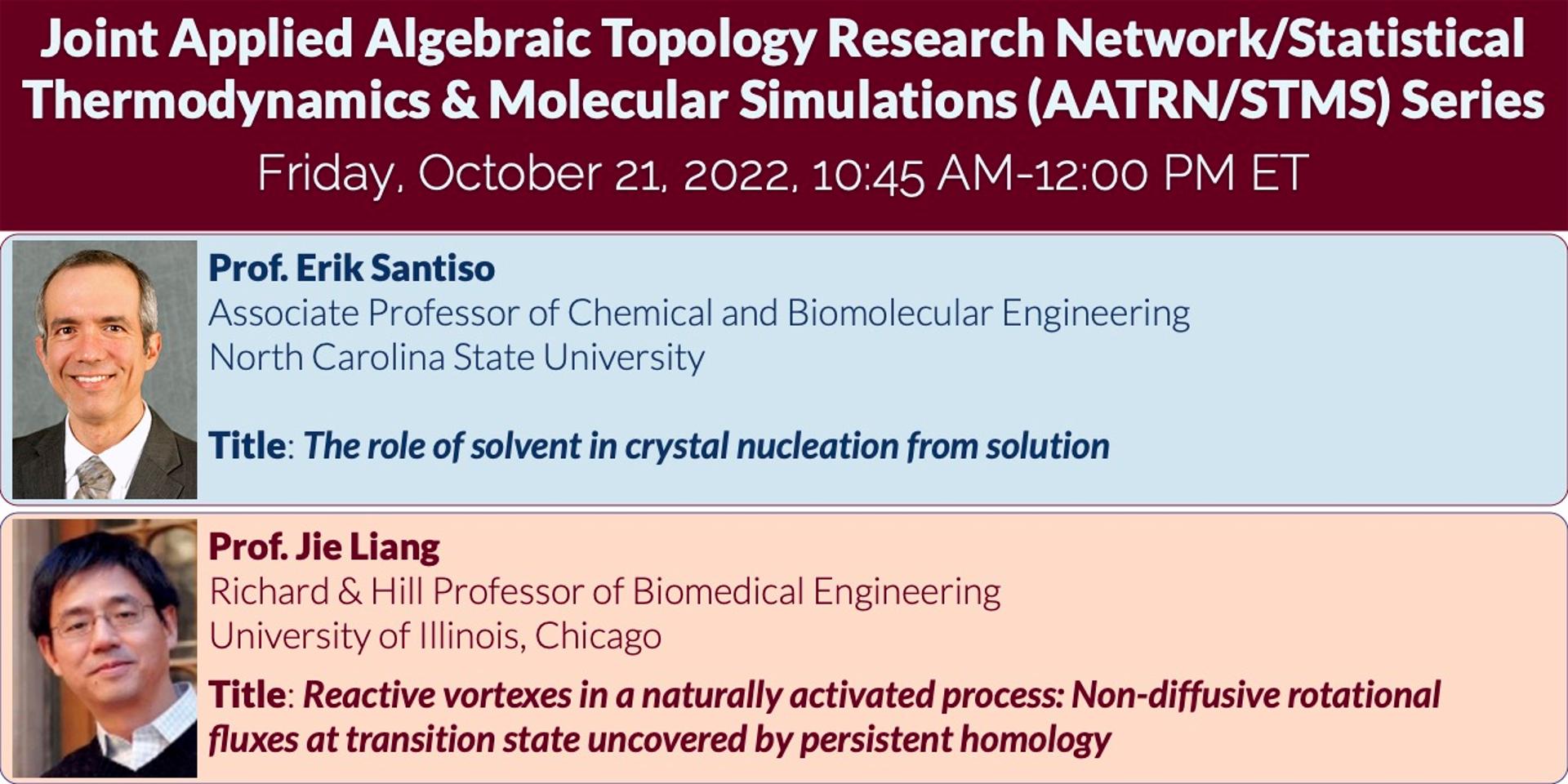
Joint Applied Algebraic Topology Research Network/Statistical Thermodynamics & Molecular Simulations (AATRN/STMS) Series
These seminar series during October 2022 are a collaboration between the Applied Algebraic Topology Research Network (AARTN) and the Statistical Thermodynamics and Molecular Simulations (STMS) seminar series. Each event will feature two speakers, one from the STMS community and the other from the AARTN community. Both speakers, however, have interests within the purview of the other community, i.e., mathematicians who work on problems that are relevant to theoretical and computational chemistry, and statistical thermodynamicists who develop and use tools from applied mathematics. As such, the intent is to enhance discussions and collaborations between these two communities. Each seminar will comprise of two 25-minute talks (one from each community) followed by questions and discussions. These four events will all take place on the four Fridays of October 20222, from 10:45 AM-12:00 PM Eastern Standard Time (EST):
This event's talks:
The role of solvent in crystal nucleation from solution
Prof. Erik Santiso (North Carolina State University)
Abstract: The study of crystal nucleation from solution is important for a wide variety of applications. However, nucleation is challenging to study both from the experimental and the theoretical/simulation perspective. In the past, we have developed simulation methods to study crystal nucleation based on a set of collective variables fitted to the known structure of the final crystalline phase(s) [1,2]. These methods have been successful in predicting the polymorphic outcome of crystallization experiments as well as correctly ranking nucleation rates in different solvents [3]. However, the collective variables do not explicitly include the solvent degrees of freedom. Previous studies (e.g. [4]) have shown that the nucleation mechanism can qualitatively change when the same substance is precipitated from different solvents, and so we hypothesize that explicitly incorporating solvent degrees of freedom in the description of nucleation can yield important information about its mechanism.
In this talk, I will present a brief overview of our approach to study crystal nucleation, and introduce a completely new method that enables us to fit collective variables sensitive to changes in the local structure of any solvent. We then present an analysis of the results from refs. [3] and [4] through the lens of these collective variables, in order to gain insight on the role of the solvent’s local structure on the nucleation mechanism.
[1] E.E. Santiso, B.L. Trout, “A general method for molecular modeling of nucleation from the melt”, J. Chem. Phys. 143, 174109 (2015).
[2] C. Liu, G.P.F. Wood, E.E. Santiso, “Modelling nucleation from solution with the string method in the osmotic ensemble”, Mol. Phys. 116, 2998 (2018).
[3] C. Liu et al., “Understanding polymorph selection of sulfamerazine in solution”, Cryst. Growth Des. 19, 6925 (2019).
[4] M. Salvalaglio, M. Mazzotti, M. Parrinello, “Urea homogeneous nucleation mechanism is solvent dependent”, Faraday Discuss. 179, 291 (2015).
Speaker Bio: Erik Santiso received his B.Sc. degree in Chemical Engineering from Universidad Simon Bolivar in Caracas, Venezuela, and his Ph.D. degree in Chemical Engineering at NC State University, where he studied the effect of confinement on phase transitions and chemical reactions. He then worked as a postdoctoral researcher at MIT and Imperial College London, doing research on crystal nucleation, crystal structure prediction and interfacial thermodynamics. In 2013 he joined the Department of Chemical and Biomolecular Engineering at NC State University, where he is now an Associate Professor. Erik’s research interests include the development of methods to study crystal nucleation, building hybrid coarse-grained models for polymers, and developing models for biomimetic polymers.
Reactive vortexes in a naturally activated process: Non-diffusive rotational fluxes at transition state uncovered by persistent homology
Prof. Jie Liang (University of Illinois, Chicago)
Abstract: Dynamics of reaction coordinates during barrier-crossing are key to understanding activated processes in complex systems such as proteins. The default assumption from Kramers’ physical intuition is that of a diffusion process. However, the dynamics of barrier-crossing in natural complex molecules are largely unexplored. Here we investigate the transition dynamics of alanine-dipeptide isomerization, the simplest complex system with a large number of non-reaction coordinates that can serve as an adequate thermal bath feeding energy into the reaction coordinates. We quantify the topological structure of the dynamic probability surface using persistent homology. Instead of a saddle-point on the free energy surface, the transition state ensemble (TSE) at the barrier top are found to form the most prominent probability H_0 peak in the high-dimensional dynamic probability surface, after reactants/products. Upon further separation of conformations along on the time axis, we uncover a space-time region with a strong reactive vortex, which is where the highest probability peak and the transition state ensemble are located. Furthermore, this reactive region contains strong rotational fluxes: Most reactive trajectories swirl multiple times around this region. Our analysis shows that the rotational
fluxes result from cooperative movement along the isocommitter surfaces orthogonal to barrier-crossing. Overall, our findings offer a first glimpse into the reactive vortex regions that characterize the non-diffusive dynamics of barrier-crossing of a naturally occurring activation process. (Joint work with Farid Manuchehrfar, Wei Tian, Huiyu Li, and Ao Ma).
Speaker Bio: Jie Liang is a Richard and Loan Hill professor in the Dept of Biomedical Engineering at the University of Illinois at Chicago (UIC), and a UIC Distinguished Professor. He received BS (Biophysics, 1986) from Fudan University, MCS and Ph.D. (Biophysics, 1994) from the University of Illinois at Urbana-Champaign. He was an NSF CISE postdoctoral fellow (1994-1996) at the Beckman Institute and National Center for Supercomputing and its Applications (NCSA). He was a fellow at the Institute of Mathematics and Applications (IMA) at Minneapolis during 1996-97, an Investigator at SmithKline Beecham Pharmaceuticals during 1997-98. He joined UIC in 1999 and became a full professor in 2007. He was a recipient of the NSF CAREER award (2003), a fellow of the American Institute of Medicine and Biological Engineering (2007), and a University Scholar (2010).
Dr. Liang's research interests include bioinformatics, protein biophysics, 3D chromosome, molecular stochastic networks, cellular pattern formation, and topological data analysis. His recent work can
be found at(http://gila.bioe.uic.edu/liang/liang_pub.html.)